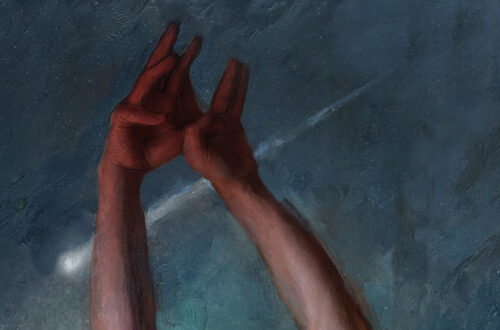
Power Up Your Creative Problem Solving: Overcome Obstacles with Confidence
As visual artists, we face challenges every day that require critical thinking and creative problem solving. Whether it’s finding inspiration for our next project, dealing with the technical issues in our artwork or navigating the competitive landscape of the art world and the dreaded spectre of self-promotion.
Despite all of this you might not recognise when you are problem solving. Worse still you might consider that problem-solving skills are an aside from what you do in your everyday practice. Something out with the intuitive world of creativity.
In fact, problem-solving skills are just as important for visual artists as they are for anyone in any other profession, maybe more so. As artists, we are always searching for new and innovative ways to express ourselves, overcome practical obstacles and bring our work to life. No matter what type of project you’re working on or what skills you’re trying to improve, you will come across problems that require critical and creative thinking to solve.
In this article I’m going to try to convince you that creative thinking is a super-charger for your problem solving skills. As a visual artist you have a natural advantage over other fields of practice when developing this skillset.
- Are problem-solving skills an important part of creative practice?
- What exactly makes creative problem solving?
- How creativity and problem-solving are connected
- Techniques to develop your creativity as a problem-solving tool
- Creative problem solving strategies specifically for visual artists
- The ongoing benefits of enhancing your creativity and problem-solving abilities
Are problem-solving skills an important part of creative practice?
Do you believe that problem-solving skills are only meant for scientists or engineers, not artists? Think again. The reality is that problem-solving is an integral and inextricable part of the creative process for all types of artistic and creative practice. Honing your problem-solving abilities, can also give your creativity a big boost.
As visual artists, we are constantly searching for suitable methods to bring our ideas to life and overcome artistic challenges. But with each new project or skill enhancement that you tackle, you will inevitably encounter roadblocks that require creative and critical thinking to overcome. If you can get these two things to work hand in hand that’s when your practice really starts to flow.
What exactly makes creative problem solving?
If you want to be a more effective problem-solver and to come up with increasingly unique and innovative solutions to your work and life challenges then harnessing the power of your creative toolset is the key.
But why exactly does creativity play such a crucial role in problem-solving? The answer lies in its ability to encourage an alternative perspective on problems. By embracing the creative mindset, you give yourself the freedom to think beyond the conventional and consider new and unconventional solutions.
This opens up a whole world of possibilities and leads to more original and effective problem-solving strategies. Research has shown that people who regularly engage in creative activities have a higher likelihood of generating unique and innovative solutions to problems.
How creativity and problem-solving are connected
It’s important to understand that there is an intrinsic link between creativity and critical thinking. In a flow state these two skills work together to help you approach problems in a more effective way. When it’s going well you probably won’t realise that they are two distinct processes at work.
When you utilise your creativity to tackle a problem, you are using your critical thinking skills to analyse the situation and identify the factors contributing to that problem. Critical thinking allows you to evaluate the problem from different angles and generate multiple solutions. Recognising and encouraging the combination of these skills will make you better equipped to find solutions that are practical but also imaginative.
So let’s try to improve your problem-solving skills and outline some exercises that will engage both your creativity and critical thinking skills.
Getting the balance right: combining creativity and logic in your problem-solving
It’s important when using creativity in problem-solving that we find a balance between imagination and logic. While it’s important to allow your creative side freedom when you’re brainstorming solutions, it’s also crucial to balance that against critical thinking.
You might find yourself with a very creative solution to a problem that is unfeasible or impractical to apply. This is where identifying practical constraints will be useful. We want to be able to find the best creative solution within the practical constraints of the situation.
Let’s keep this in mind while when we apply these techniques.
Techniques to develop your creativity as a problem-solving tool
You possess a valuable asset in your creativity. To be able to solve problems effectively, it’s crucial to enhance and cultivate this asset. But how can we do that? The answer lies in being proactive and intentional about developing your imagination and creative thinking.
Let’s look at five specific strategies that will help you enhance your creativity as a tool for problem-solving. These strategies are mostly well known and tried and tested. They can be applied to any situation where you are struggling to find a solution to a problem.
Mind mapping
This is a technique, popularized by Tony Buzan, allows you to visually organise information and ideas in a non-linear way, helping you to make connections and uncover relationships between the different elements. By stimulating your imagination, mind mapping can help you generate new and innovative solutions to problems.
Mind mapping works for this because it allows you to realise associations that are not obvious to you. The act of drawing and categorising as you go reveals relationships to you between the nodes of the mind map. These relationships were possibly not clear to you before drawing them out. The act of drawing them out can be revealing in itself.
Mind mapping can also stimulate your memory and help you to remember the concepts you are working with afterwards. This can beneficial for your the creative process. You want to be able to step away from
In the Buzan mind-mapping method using colours and images is also encouraged as it stimulates the right side of the brain. There are plenty on-line mind mapping tools that allow you to do this including popular tools such as Canva. Canva for example has pre-made attractive templates that are very easily customisable and where images can be added easily.
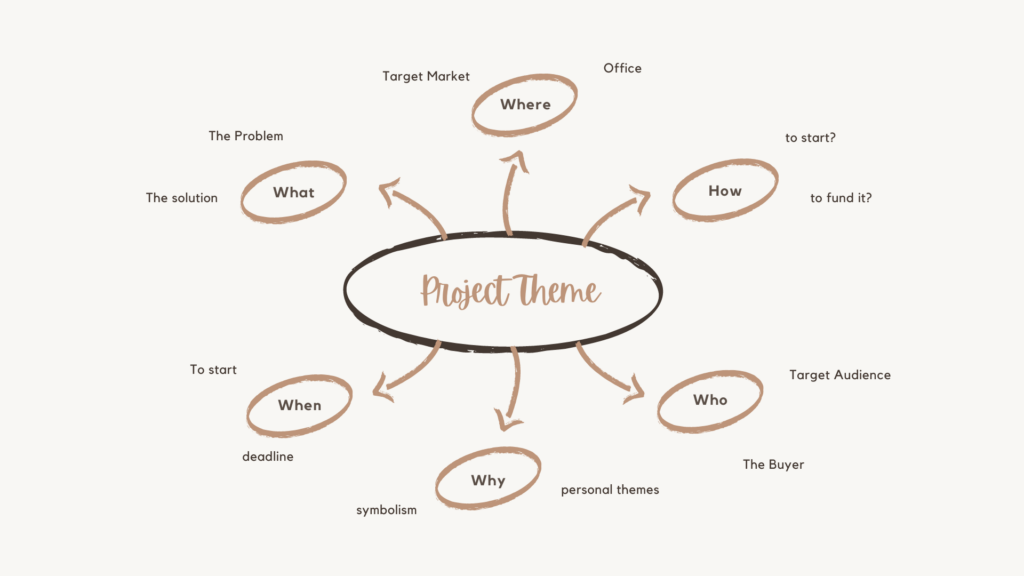
Whether you’re brainstorming ideas, exploring possibilities, or identifying opportunities, mind mapping is a powerful tool to have in your problem-solving arsenal.
Ideation drawing for creative probelm solving
If you haven’t encountered ideation drawing before it is a technique that involves sketching out ideas, concepts, and solutions. The focus is on working quickly and spending time trying to create a ‘good drawing. This method is a very effective method of tapping into your creative potential and allowing yourself to think freely and openly.
Ideation drawing is not only for visual creatives. It can be used to stimulate imagination and creative problem solving in business applications, design, narrative building and any other problematic situation that you might encounter. Don’t let the word drawing put you off. The benefits of even simple drawing for creative thinking are widely heralded; “students who drew productive diagrams were more successful problem solvers” [sources 1 | 2 ].
When you engage in ideation drawing, you can quickly and easily jot down your thoughts and ideas, without the need for precise accuracy. This type of drawing is meant to be rough and messy. It allows you to focus on the creative process rather than the final product. It’s a useful method of creating rough versions of ideas or concepts that require iterative thinking.
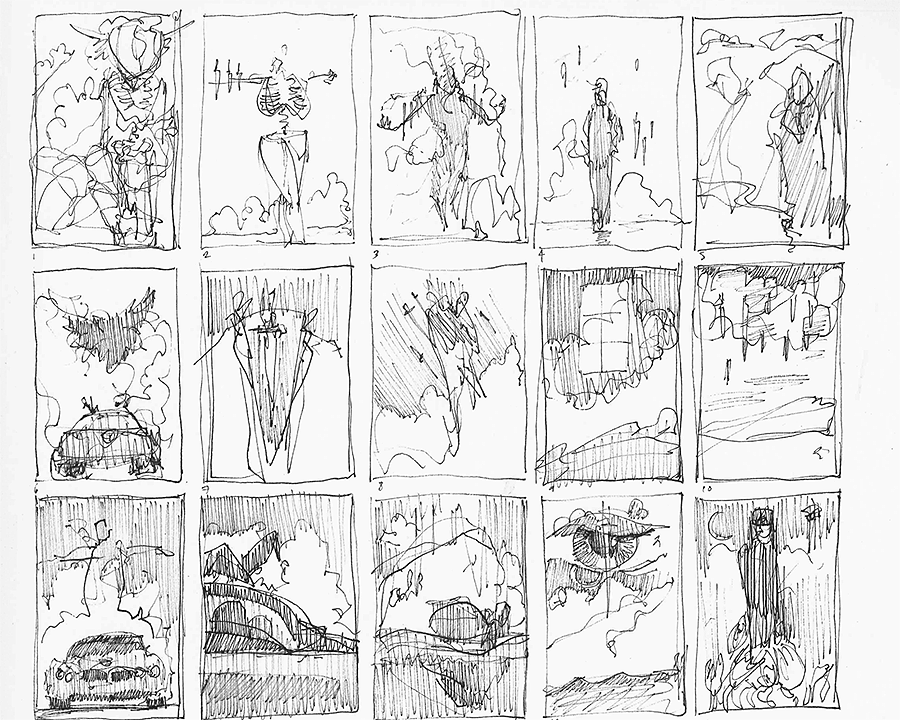
In my own classes the satisfaction level of students work who engage with ideation drawing more fully is much higher than in those who don’t use the technique. Read about more about the process of ideation drawing in this article.
The power of play, experimentation and mistakes
Play, experimentation, and mistakes are all essential components of a creative process. When you allow yourself permission to play and experiment, you unbind yourself from the discipline that dominates your field. With a more relaxed and deliberately lighter intent you are more likely to approach problems from new and unique perspectives.
Remember that mistakes are not failures, but rather opportunities for growth and learning. Embrace play and experimentation in your practice, and be willing learn from your mistakes. We are all too quick to discard unsuccessful projects and move on from them. Often we just want to cover up the failure of a project and move on. Change your mindset if you think like this. Bring your less successful projects out and show them off, be proud of them. More importantly be proud to show what you have learned from them.
Through the pure fun of experimentation you can expand your creative abilities and grow to become more confident in your creative problem-solving skills. When we are children the self-consciousness about being imaginative and playing experimentally is much less dominant. Creativity levels in children are higher as a result.
It took me four years to paint like Raphael, but a lifetime to paint like a child.
Pablo Picasso
When you are trying to solve a problem or develop your creative thinking skills, reframe the problem as play and experimentation. What happens if I…? Run the problems and possibilities without restraint and without the fear.
Change your perspective of the problem
When your thinking is entrenched in habitual patterns it can make creative problem solving difficult. This is when you can benefit from a change in your thinking. There is much research published [sources 1 | 2] that espouse the benefits of physical movement for prompting better thinking. When you are trying to problem solve get out of your seat and go for a walk. The simple act of changing your physical environment can stimulate ideas.
The Stanford University research paper ‘Give Your Ideas Some Legs: The Positive Effect of Walking on Creative Thinking’ (Marily Oppezzo and Daniel L. Schwartz) has shown that physical movement particular supports the type of thinking (divergent thinking) that is required in early stages of problem solving, mind-mapping and brain storming.
Additionally it can be helpful to shift your thought perspective on the issues at hand. To do this try to reframe it in a different way. There is a tool for doing this called a reframing matrix. Although this was developed mostly from a business perspective it can apply equally to creative ventures as I will demonstrate below.
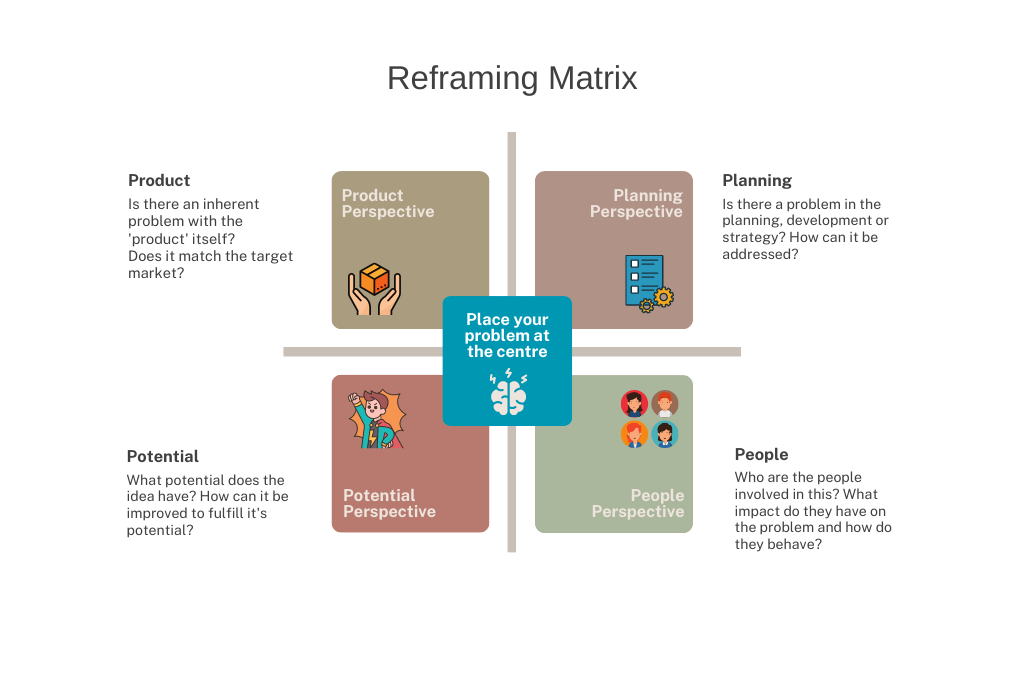
The reframing matrix technique was developed by Michael Morgan in his 1993 book “Creating Workforce Innovation: Turning Individual Creativity Into Organizational Innovation”. One of the strengths of this problem solving approach is that people from different roles involved in the problem can all give a range of feedback from the different perspective points. This feedback can then be used to collectively brainstorm solutions. Each sector of the diagram reframes the problem from a different perspective. This reframing helps us to break our patterns of entrenched thinking about the problem.
Read on to find out how you can use an adapted version of the reframing matrix to help you with creative block if you are a visual artist.
Creative problem solving strategies specifically for visual artists
The methods outlined above are general problem solving methods and are useful for you to consider. The following set of techniques are aimed more squarely at visual artists although can be adapted for use in other disciplines. The Creative Project Reframing Matrix in particular can be used for visual arts, writing, music, animation or anything that is created by you and has a potential audience.
A change of perspective; The Creative Project Reframing Matrix
We looked at the classic reframing matrix for business problems. Let’s look at how we can adapt that model for our creative projects. The Creative Project Reframing Matrix below takes the same concept but reframes if for our creative endeavours. If you find yourself stuck on a bit of work and struggling to progress it then using this tool might help you to break out of your regular thinking patterns.
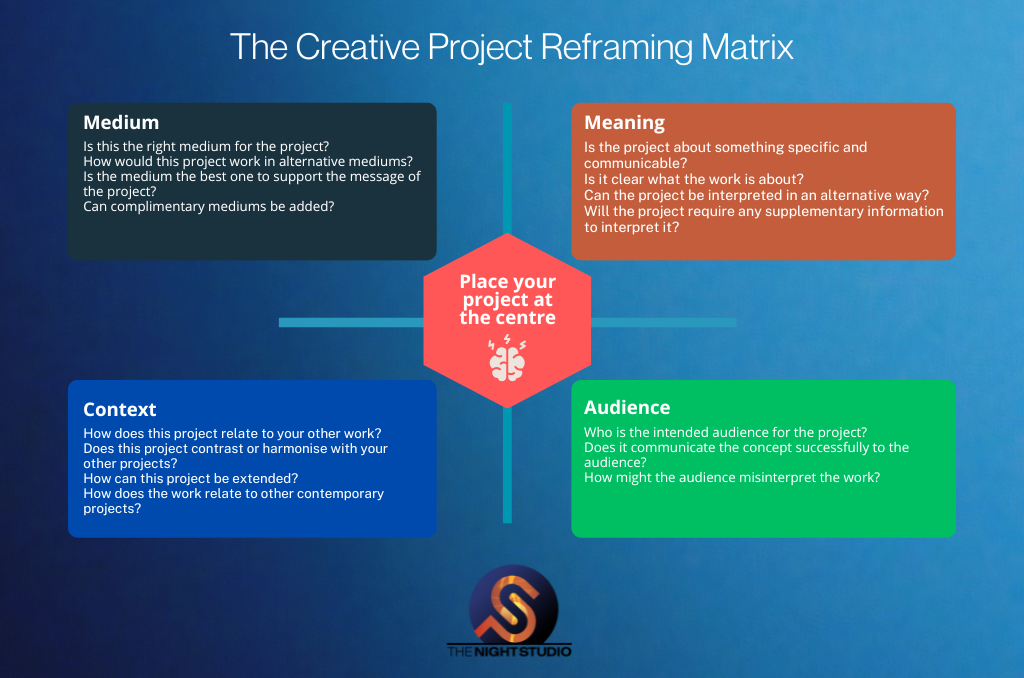
Draw a simple cross grid and place your creative project at the centre. Work through the surrounding sectors one at a time to challenge your perspectives about the project area by area.
The Medium Perspective
From the perspective of medium ask yourself the following types of questions. Have you selected the best medium for this project? How might it work in alternative mediums? Can the work be extended to other mediums? Is there something complementary that you could create in a different medium that relates to this project and supports it?
Sometimes we get too attached to one way of working and don’t think to try other methods. A well known cure for creative block is to switch mediums and try something different.
The Meaning Perspective
In this sector consider what the meaning of the work is? What is it meant to convey? What response is it meant to elicit in the audience? Is the project about something that is meaningful (if only to you) and communicable? Sometimes I see students projects falter because they have a lack of central meaning to the creator. This lack of meaning translates eventually into a lack of momentum.
Ask yourself also if your audience will need help to interpret the work. Is it possible that there could be alternative interpretations? What can you do to bring clarity to the meaning of the project?
The Context Perspective
It is often helpful to reframe your project in terms of the wider context. This can be both in terms of your own work but also more widely. How does this project relate to other contemporary work in the same field? Does this project sit harmoniously with your other projects or does it jar against them in terms of content or style? It is also worth considering how this project can be extended to a greater scope. Does it have the potential to become a body of work in itself? Is it part of an existing body of work?
Ask yourself (and others) what the potential of the project is ultimately. Someone once told me that if we are lucky we only get a few big ideas in our life. If that’s the case you don’t want to miss out on the potential of any of them.
The Audience Perspective
If you have created with an audience in mind try subverting your expectations of how they might perceive the work. Is there room for misinterpretation? Does the project communicate the idea(s) to your audience successfully? Who do you think the audience for the work actually is? How can you modify the perspective of the project to speak more directly to them? Or to include a completely different audience?
Extend the use of the reframing matrix by asking your peers and other creatives to feed into your matrix. Connect the project to other practitioners and let them contribute to the feedback.
Experiment with new materials and techniques
We’ve mentioned this above several times but it bears re-enforcing. You can often instigate a change in perspective by shifting away from your usual methods and materials. Using the same techniques again and again leads you to re-enforce the same patterns of thinking in relation to those techniques. That’s how we learn and become adept in our chosen field. The brain reinforces neural pathways by repetition making tasks more fluid and easier to perform because the actual physical connections in the brain get stronger. Sometimes this can be a disadvantage however.
If we get bogged down in a problem with our project it can be helpful to short circuit these patterns for a while and build some new connections. Swapping methods of working can support this. For example if you are painting, try swapping to printmaking for a while using the same source material and stimulus. This reframing of the work like this will stimulate your creativity. You will be realising the same idea but in an altogether different way by virtue of the fact the materials are different.
Running down the muse: overcoming creative blocks and finding inspiration
This really needs a whole article on its own, or a series of articles. In fact most of the resources on this site are about just this subject. When you are stuck in a creative block you have stopped successfully problem solving. In fact you may have stopped even being able to define what the problem is at all.
There is nothing more frustrating than feeling creatively empty. Overcoming this challenge is not an easy thing to do and it often requires a combination of approaches that are sustained and have momentum. Below I’ve listed some of the approaches that you might take to start to re-gain momentum for yourself.
This list is not exhaustive and will likely need more than one approach but it is a starting point. Many of the points here either have articles about them already or are in production. I’ll update the list as I continue to publish.
- Practice ‘free’ drawing or writing, this is creating without any plan or structure. Effectively drawing or writing whatever comes into your head. It is a good technique that you can use to overcome creative block, generate ideas, or explore topics without any constraints or limitations.
- Practice mindfulness and engage in the development of your self-awareness. Re-evaluate what you are doing to make sure that it aligns with who you are creatively. I’ve found that projects sometimes stall because they are not actually aligned with my longer term creative aspirations.
- Use listings of pre-defined ideas and prompts and challenges to get momentum. You might not be creating exactly what you want but sometimes we need an external influence to get the ball rolling.
The ongoing benefits of enhancing your creativity and problem-solving abilities
One of the reasons that creativity is valued so much in our modern society is its super potential for enhancing problem solving. Tapping into your creativity and incorporating problem-solving strategies like the ones outlined above can unlock new levels of innovation and solution-finding.
Cultivating your creativity and your ability to solve problems is an ongoing process that takes time and an accumulation of experience. The practice of nurturing and practising your creativity will not only enhance your problem-solving skills, but will also bring increased self-awareness, and a sense of fulfilment to your projects. I hope this been helpful, have fun creating.


